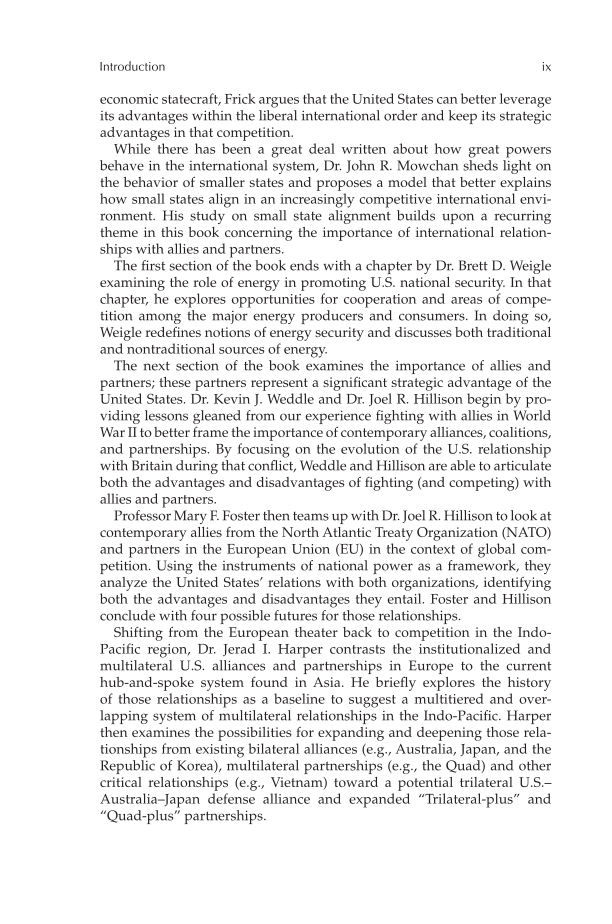Introduction ix economic statecraft, Frick argues that the United States can better leverage its advantages within the liberal international order and keep its strategic advantages in that competition. While there has been a great deal written about how great powers behave in the international system, Dr. John R. Mowchan sheds light on the behavior of smaller states and proposes a model that better explains how small states align in an increasingly competitive international envi- ronment. His study on small state alignment builds upon a recurring theme in this book concerning the importance of international relation- ships with allies and partners. The first section of the book ends with a chapter by Dr. Brett D. Weigle examining the role of energy in promoting U.S. national security. In that chapter, he explores opportunities for cooperation and areas of compe- tition among the major energy producers and consumers. In doing so, Weigle redefines notions of energy security and discusses both traditional and nontraditional sources of energy. The next section of the book examines the importance of allies and partners these partners represent a significant strategic advantage of the United States. Dr. Kevin J. Weddle and Dr. Joel R. Hillison begin by pro- viding lessons gleaned from our experience fighting with allies in World War II to better frame the importance of contemporary alliances, coalitions, and partnerships. By focusing on the evolution of the U.S. relationship with Britain during that conflict, Weddle and Hillison are able to articulate both the advantages and disadvantages of fighting (and competing) with allies and partners. Professor Mary F. Foster then teams up with Dr. Joel R. Hillison to look at contemporary allies from the North Atlantic Treaty Organization (NATO) and partners in the European Union (EU) in the context of global com- petition. Using the instruments of national power as a framework, they analyze the United States’ relations with both organizations, identifying both the advantages and disadvantages they entail. Foster and Hillison conclude with four possible futures for those relationships. Shifting from the European theater back to competition in the Indo- Pacific region, Dr. Jerad I. Harper contrasts the institutionalized and multilateral U.S. alliances and partnerships in Europe to the current hub-and-spoke system found in Asia. He briefly explores the history of those relationships as a baseline to suggest a multitiered and over- lapping system of multilateral relationships in the Indo-Pacific. Harper then examines the possibilities for expanding and deepening those rela- tionships from existing bilateral alliances (e.g., Australia, Japan, and the Republic of Korea), multilateral partnerships (e.g., the Quad) and other critical relationships (e.g., Vietnam) toward a potential trilateral U.S.– Australia–Japan defense alliance and expanded “Trilateral-plus” and “Quad-plus” partnerships.
Document Details My Account Print multiple pages
Print
You have printed 0 times in the last 24 hours.
Your print count will reset on at .
You may print 0 more time(s) before then.
You may print a maximum of 0 pages at a time.











































































































































































































































































































































































